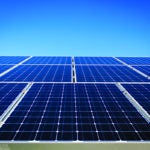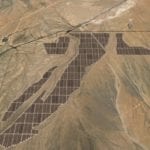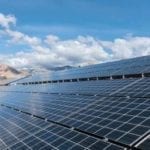Two planned solar projects in Nevada would be the first in that state to include battery storage, part of an increasing trend toward such projects to help mitigate issues with integrating renewable energy into the larger transmission grid. Both projects are scheduled to begin construction next year pending regulatory approval, with the Bureau of Land Management currently taking public comment on the projects as part of environmental reviews.
At least one of the projects could help power the famed Las Vegas Strip. The proposed Gemini Solar Project is a $1 billion endeavor that could provide electricity to parts of Nevada, Arizona, and California as early as 2020.
Adding storage capacity to utility-scale solar projects is an increasing trend, particularly in the solar-rich Desert Southwest, according to Steve Fine, a vice president in the Energy Advisory and Services practice who leads the Distributed Energy Resources team with global consulting services company ICF. Fine, in a phone interview with POWER on July 30, said, “The power sector in general, as it needs to become less and less carbon-intensive, is turning to solar generation. The challenge is when you’ve got so much solar in an area like that, California, Arizona, Nevada, you’re going to run into the issue of integrating more renewable energy onto the grid.”
Fine noted that solar plus storage helps solve the issue of the famed “duck curve” when it comes to solar generation. “CAISO [California Independent System Operator] saw this coming in 2013. It turns out they were pretty spot-on with their forecast. It’s actually happened faster than they forecast. Storage has the obvious advantage to flatten the belly of the duck during the day and bring down the neck of the duck during the evening [demand] peaks.”
Pairing solar with storage certainly makes sense in Las Vegas, where demand for electricity has long outstripped local generation. The Gemini project is sited on federal land about 25 miles northeast of downtown Las Vegas. Its developer, Houston, Texas-based Quinbrook Infrastructure Partners, said its plans to install 690 MW of solar power capacity and up to 200 MW of battery storage.
The second project, the Yellow Pine Solar Project near Pahrump, is west of Las Vegas. It would combine photovoltaic solar panels and lithium-ion batteries to generate as much as 500 MW of power for Nevada. It is sited on public land near the border with California. It is being developed by Yellow Pine Solar LLC, a wholly-owned indirect subsidiary of Florida-based NextEra Energy Resources.
Jeff Hunter, senior managing director of Quinbrook, in a recent news release said, “Gemini is a uniquely positioned project in close proximity to both Las Vegas and export connections to California and Arizona. Solar energy is on the rise in Nevada and is now being offered at historic low prices which is great news for retail consumers and local industry. We share the state’s commitment to minimizing the impact on Nevada’s land, water, and wildlife as renewable energy facilities are incorporated.”
In a recent interview with Bloomberg News, Hunter said: “In California, I’d sincerely doubt you’d build a solar project without a battery.” Construction on the Gemini project is scheduled to begin in the second half of 2019.
The project would be among the largest solar projects in Nevada. Quinbrook is financing the project, with final development and construction led by project partner Arevia Power. Gemini would have two nearby interconnections. The project’s first phase of 440 MW would connect to NV Energy’s Crystal Substation via a 230-kV AC interconnection, with the electricity going to NV Energy’s local grid. The project’s second phase of 250 MW has a planned interconnection at the South Crystal Substation via a 525-kV line, and would provide power for customers in Nevada, California, and Arizona.
Several large U.S. solar projects have been proposed recently with an eye toward taking advantage of federal government incentives that are scheduled to phase out over the new few years. Several co-ops also are increasing their use of solar power. In addition, more projects in Western states are taking shape after the Trump administration earlier this year said it would review Desert Renewable Energy Conservation Plan, an Obama-era plan that imposed restrictions on where solar and wind projects could be sited in the California desert.
Environmental groups in California and Nevada have historically opposed utility-scale solar projects in desert locations in those states due to their impact on native wildlife and plants. Nevada Gov. Brian Sandoval, a Republican, has said he supports the expansion of renewable energy in the state. California Gov. Jerry Brown, a Democrat, has said the state is on track to achieve its 2030 renewable portfolio standard requirement of 50% power generation from renewables, and many state lawmakers have called for California to pursue a goal of 100% generation from renewables.
Read more coverage of solar power from POWER magazine:
Solar Power Hits New Highs in Britain
Floating Solar Panel Industry Makes a Splash
Net Metering and Time Variant Rates Drive Solar Power and Energy Storage Growth [PODCAST]
FPL Will Build New Gas Plant, Adds More Solar
Largest Solar Plant in Southeast Will be Built in Georgia
—Darrell Proctor is a POWER associate editor (@DarrellProctor1, @POWERmagazine).









